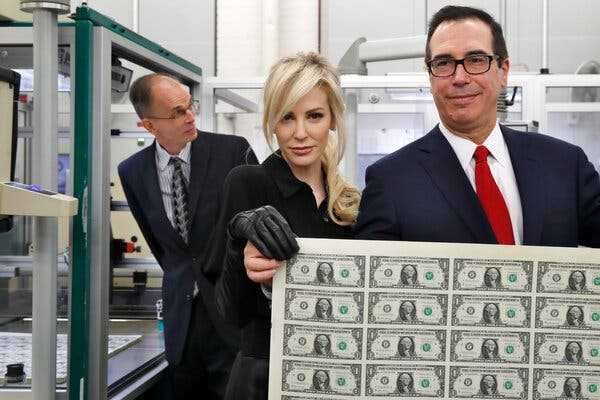Until a new treasurer is selected, currency will continue to bear the autograph of former Treasury Secretary Steven Mnuchin.

Treasury Secretary Steven Mnuchin and his wife, Louise Linton, posing with a sheet of new $1 bills bearing his signature in 2017. Mr. Mnuchin is no longer secretary, but the bills still include his name.
WASHINGTON — At a now infamous 2017 ceremony inside the Bureau of Engraving and Printing, Steven Mnuchin, the Treasury secretary at the time, and his wife, Louise Linton, posed for the cameras with an uncut sheet of $1 bills, the first to bear his signature.
The images went viral, prompting comparisons of Mr. Mnuchin, a former Goldman Sachs banker, to a Bond villain.
More than four years later, America has a new Treasury secretary, Janet L. Yellen. But the U.S. currency continues to bear Mr. Mnuchin’s signature.
The reason has to do with the vagaries of Washington bureaucracy and the fact that, despite having a Treasury secretary in place since January, President Biden has yet to appoint a United States treasurer. The two signatures must be added to new series of currency in tandem, meaning that the process of adding Ms. Yellen’s signature to the greenback is frozen for the foreseeable future.
Ms. Yellen sat for her currency signing in March, meeting with the Bureau of Engraving and Printing director, Leonard Olijar, and providing her official signature for printing on the new 2021 series of paper currency. At the time, the Treasury Department said in a statement that it would “reveal her signature in the coming weeks.” Nine months later, Ms. Yellen’s signature is nowhere to be seen on America’s bank notes, depriving the first woman to be Treasury secretary of one of the job’s prized perks.
“It is a little odd,” said Franklin Noll, the president of the Treasury Historical Association.
Previous Treasury secretaries have had their signatures added to money, a process which takes several months, within their first year on the job.
The delay owes to the slow pace of White House nominations across the federal government, including at the Treasury Department. By tradition, the treasurer must also sign the money along with the secretary, and both signatures are engraved on plates, printed and submitted to the Federal Reserve, which determines what currency will be added to circulation.
Since the Treasury secretary has the ultimate say over currency design, in theory Ms. Yellen could do away with the tradition and incorporate her signature right away.
The treasurer post, which oversees the Bureau of Engraving and Printing and the U.S. Mint, does not require Senate confirmation. But even if Mr. Biden appointed someone before year-end, it could take until mid-2022 before the new series of notes was in circulation.
The White House appears to be in no rush. A spokesman said that while Mr. Biden is actively considering treasurer candidates, the administration’s priority has been on filling Senate-confirmed positions that are important for protecting national security and combating the pandemic.
The Treasury Department declined to comment and referred an inquiry to the White House.
The history of who gets to sign the money dates to 1861, when President Abraham Lincoln signed a bill allowing the Treasury secretary to delegate the treasurer of the United States to sign Treasury notes and bonds. According to the Bureau of Engraving and Printing, 1914 was the first year that the Treasury secretary and the treasurer started signing the currency together.
In recent years, the signature of the secretary has captured the nation’s attention, as changes to America’s currency are relatively rare.
Former Treasury Secretary Timothy F. Geithner acknowledged in 2012 that handwriting was not his strong suit and that he polished his penmanship when President Barack Obama offered him the job.
“I didn’t try for elegance,” Mr. Geithner said. “I tried for clarity.”
Clarity was an Achilles’ heel for Jacob J. Lew, Mr. Geithner’s successor whose loopy autograph was laughed at for being illegible. Mr. Obama joked in 2013 that Mr. Lew, who had been his chief of staff, nearly did not get the job out of concern that his scrawl would debase America’s currency.
Early versions of Mr. Mnuchin’s signature on personal documents were not easy to read. But ultimately, former President Donald J. Trump’s Treasury secretary broke with tradition and wrote his name in print rather than cursive.
The signatures are closely watched by collectors and students of financial history.
Mr. Noll said that during events or lectures at the Treasury Department with former secretaries, attendees would often bring money to be “countersigned” next to their name on the note.
“It was kind of cool to get the real signature,” Mr. Noll said.
Ms. Yellen’s signature on the money is not the only change to America’s currency that has been delayed. Soon after Mr. Biden took office this year, White House officials said the administration would accelerate efforts to have Harriet Tubman’s portrait grace the front of the $20 bill, a process that stalled under Mr. Mnuchin.
However, at a congressional hearing in September, Ms. Yellen indicated that doing so would take some time, saying that redesigning the note is a lengthy process given the need to develop robust anti-counterfeiting features.
Rosie Rios, who served as Treasurer under Mr. Geithner and Mr. Lew during the Obama administration, said that it was a privilege to have her signature on nearly $2 trillion worth of currency that is in circulation. Having helped to lead the effort to get images of women added to U.S. currency, she said, she will find it meaningful to have Ms. Yellen’s name on the money.
“I’m very excited to see Secretary Yellen’s signature on there,” she said.
Source: nytimes.com



